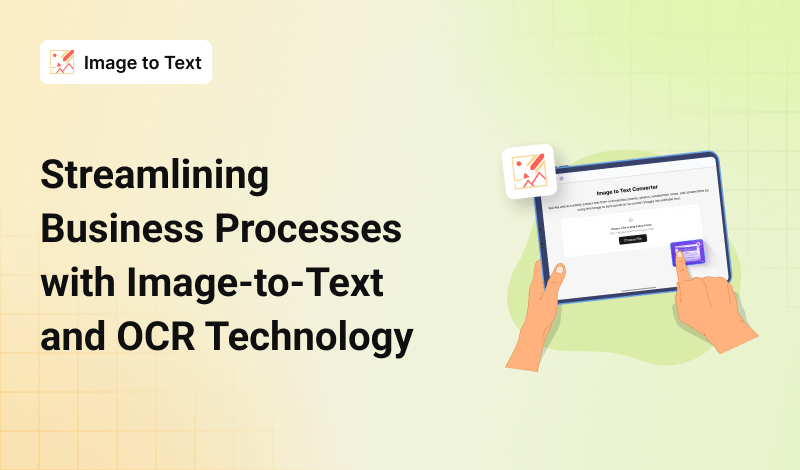The technology known as optical character recognition (OCR) enables the identification and extraction of text from images, such as scanned photos, handwriting notes or documents. OCR technology analyzes an image's visual characteristics using complex algorithms before turning it into editable, searchable text.
Due to the growing volume of data and documents that businesses produce and receive, Optical technology is playing a bigger role in business processes. This technology facilitates businesses in streamlining their data entry and document processing tasks, resulting in improved efficiency, accuracy, and cost savings.
How Image-to-Text and OCR Streamline Business Processes
Automated data entry
Manual data entry is a time-consuming and error-prone task that involves manually inputting data from physical documents into a digital format. It simplifies data entry by automatically recognizing and extracting text from scanned documents or images. This automated process by using image to text saves time and reduces the risk of human error.
Document processing
Manual document processing involves physically handling documents and processing them by hand. This process can be slow, error-prone, and costly. It can automate the document processing process by recognizing and extracting relevant information from scanned documents. This leads to faster processing times and reduces the need for manual document handling.
Record keeping
Manual record keeping involves maintaining physical copies of documents, such as invoices, receipts, and contracts. This process can be time-consuming and can lead to issues with document retrieval and storage. And, allows businesses to digitize their records and store them electronically. This makes document retrieval faster and easier and also reduces the need for physical storage space.
Customer service
It can enhance customer service by enabling businesses to quickly and effectively retrieve customer information. Such as order history and account details. Examples from real-world businesses show how this technology has improved customer service.
Online retailers that use OCR to extract customer information from shipping labels are a few examples of companies that have used the technology to enhance customer service. Healthcare providers that use OCR to automate patient intake forms.
Benefits of Streamlining Business Processes with Image-to-Text and OCR
It offers a wide range of benefits in streamlining business processes, including automated data entry, improved document processing, efficient record keeping, better customer service, and enhanced data security.
Boosted efficiency
The utilization of technology simplifies business operations by mechanizing laborious manual duties, like entering data and processing documents. This culminates in an upsurge in efficiency and output, enabling workers to concentrate on more significant duties. The automation of data entry and document processing diminishes the time required to execute these activities.
Reduced costs
It reduces costs by reducing the need for manual labor and paper-based document storage. Automated data entry and document processing reduce the number of employees needed to complete these tasks, leading to significant cost savings.
Upgraded accuracy
Moreover, improves accuracy by reducing the risk of human error in manual data entry and document processing tasks. Manual data entry is prone to errors, such as typos or transcription errors, which can lead to inaccurate data. Eliminates the need for manual data entry. It reduces the risk of errors and ensures greater accuracy in business processes.
Better customer service
It enables businesses to quickly and effectively retrieve customer information, which can enhance customer service. Businesses can quickly and easily access customer information using OCR technology, which speeds up responses and enhances customer service.
Enhanced data security
It can enhance data security by allowing businesses to securely store electronic copies of documents and limiting access to sensitive information. Electronic storage of documents with this technology reduces the risk of physical document loss or damage. It enables businesses to control access to sensitive information through advanced security features.
Obstacles in Implementing
Technical challenges
Technical challenges in implementing technology can include issues with image quality, font recognition, and document layout. Technical challenges can be overcome through the use of advanced OCR technology, such as machine learning algorithms. The same can be achieved through proper image and document preparation, such as using high-quality images and consistent document layouts.
Cultural challenges
Cultural challenges in implementing this technology can include resistance to change and a lack of technical expertise. There are also concerns about data privacy and security. Cultural challenges can be overcome through proper communication and training to address any concerns or questions about OCR. In addition, it can be implemented by implementing strong data privacy and security measures.
Summary
OCR technology is an important tool for businesses looking to streamline their document processing and data entry tasks, leading to increased efficiency, accuracy, and reduced costs. Businesses should consider adopting That technology to take advantage of its benefits and improve their overall business processes. With the right implementation strategies, businesses can overcome any challenges and successfully integrate OCR into their operations.




